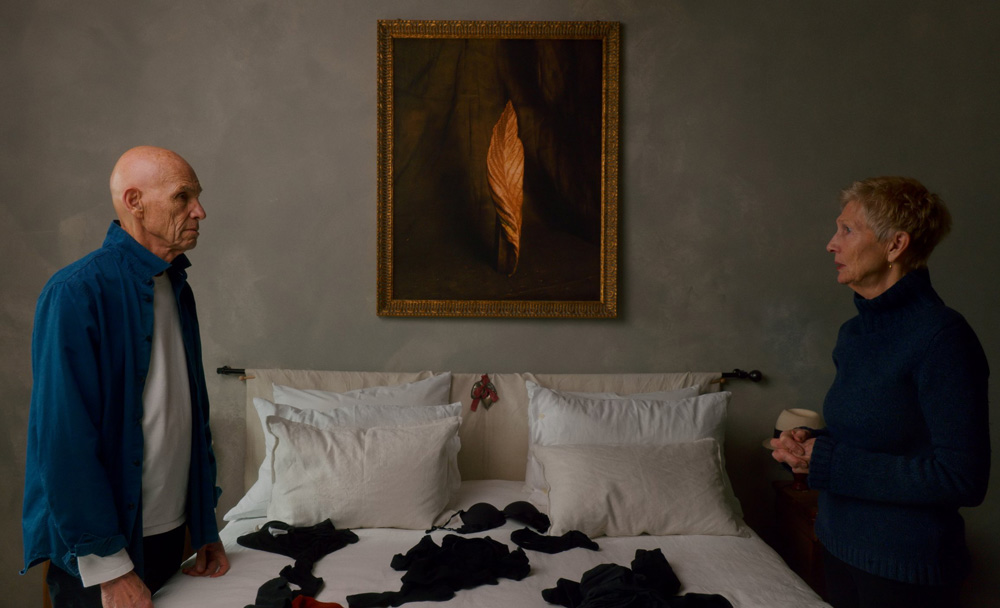Early on in “Two Strangers Trying Not to Kill Each Other,” co-directors Manon Ouimet and Jacob Perlmutter are able to condense a marriage into a single frame, looking on as the photographer Joel Meyerowitz and Maggie Barrett, an artist in her own right, attend a gallery opening for a new show of his. The two are enjoying a casual conversation with well-wishers positioned just off-camera, each on separate subjects and the scene wouldn’t appear to reveal much about the pair when the chitchat is mundane and standing against the largely white backdrop of the gallery, there isn’t much more said about who they are, but Ouimet and Perlmutter take the clever tact of alternating whose mic is on as the moment unfolds and the two can carry on without exchanging words with one another, sharing a space but not necessarily a wavelength as their relationship enters its fourth decade.
It’s a great tribute to Meyerowitz, a legendary New York-born street photographer who was once deigned the only one to take on-site pictures of ground zero in the immediate aftermath of 9/11, that there’s such a depth to nearly every frame in Ouimet and Perlmutter’s considerate portrait of a partnership, but always leaving room for Barrett honors what she is going through when she hasn’t had the professional success that he has and being 10 years younger also has started to weigh on the couple. Barrett is openly thinking about death when “Two Strangers Trying Not to Kill Each Other” begins, seemingly closer to it even though it’s Meyerowitz who is 84 and as she tells him as she’s started seeing signs of him slowing down, “Suddenly, I’m living the 84 too and I don’t want to be.” Her concerns would seem to be rooted less in what her husband’s health actually is than what she experienced before he could provide her with some stability, having worked through four other marriages, a drug addiction and multiple career changes before locking eyes with Meyerowitz after the end of his first marriage. Now she doesn’t know whether she’d rather go first when she knows he’d be bereft without her or lose the comfort of passing away with him around to care for her in her final moments.
The film’s title alludes to a generally lighthearted treatment of such matters in line with the relationship that Meyerowitz and Barrett actually have, but the film itself nonetheless carries quite a bit of dramatic heft when the couple’s idyllic life in Tuscany where the two should be enjoying the simple life is fraught with the knowledge that when the photographer’s accomplishments have surely paid for the bulk of the Italian villa, Barrett, who now writes novels after a number of other artistic pursuits, can’t feel she’s achieved much of anything. The situation only worsens when she literally suffers a bad break, injuring her femur, which causes an even greater reliance on Meyerowitz and brings about more acute feelings of inadequacy, particularly when she’s laid up in bed and he can continue his work when not by her side.
Although it’s clear from the film’s staggering opening image, in which the divide between the couple is presented in stark terms with Meyerowitz perched on a staircase as Barrett is down a floor playing a piano, that what you’re seeing is far from cinema verite, ordinary scenes from the marriage do vividly reflect their reality. It could risk being unfair to Barrett that any of the issues she brings up about Meyerowitz being callous or showing his age in arguments that the two have aren’t accompanied by any visual evidence — it’s a no-win situation for her when she’s seen as either irrational for pointing out what an audience never sees or angry about something Meyerowitz, who is portrayed as a gentle soul, hardly seems capable of — but one gets the sense that the tension between her insecurities and his calm has been part of what’s kept the couple engaged for as long as they have.
More impressive, however, is how Ouimet and Perlmutter can speak to an entire history in the present tense, actively presenting Meyerowitz and Barrett shaped by a history that they only spend a few minutes on upfront and establishing the latter as someone who has had to fight for every good thing in her life while it’s all seemed to come much more easily for the former. When the couple’s attraction to one another was based in the reasons that could now put them at odds, the film makes time tactile when being able to see less road ahead than behind them has made Meyerowitz and Barrett more conscious of what they want and balancing their needs versus that of their partner has only become more difficult. As pretty as individual scenes are throughout “Two Strangers Trying Not to Kill Each Other” when both the compositions and the subjects are vibrant, they last not because of their obvious beauty but when they are a brilliant expression of endurance in and of itself.
“Two Strangers Trying Not to Kill Each Other” does not yet have U.S. distribution. It will next play the London Film Festival on October 10th at 8:30 pm at ICA 1 and October 14th at noon at BFI Southbank.




